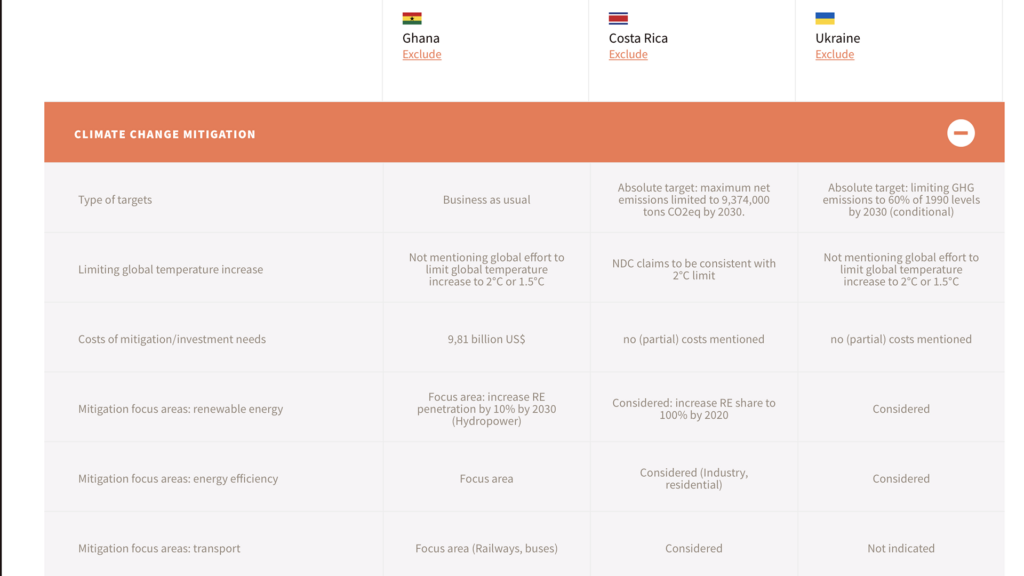NDCs are the pledges countries make toward meeting the internationally recognized goal of keeping global temperature increases to well below 2°C above pre-industrial levels. NDCs embody their efforts both to reduce emissions and to adapt to the impacts of climate change.
SEI works with countries to help them apply its energy and emissions modeling software called LEAP to examine the potential for more ambitious NDCs. Charlie Heaps is the developer of LEAP and a senior scientist at SEI.
What are the practical steps towards adopting or enhancing an NDC?
NDCs are not just about identifying GHG mitigation opportunities. They are also about planning a future that can meet countries’ development aspirations.
We work with planning agencies and ministries in developing countries to support them in better understanding their current energy use patterns and identifying where they are headed under current policies — as well as what are the opportunities promoting development and reducing GHG emissions. Oftentimes, information is surprisingly sparse, especially about how energy is being consumed and where emissions are coming from, so it is important to start by improving the understanding of these issues. A starting point is that you cannot manage what you do not measure!
The first nationally determined contributions, then called “intended nationally determined contributions” (INDCs) were made at the 2015 Paris climate conference. The Paris Agreement reached at that conference requests countries to submit updated NDCs every five years to the UNFCCC secretariat; the next round is due by 2020.
Countries are encouraged to submit NDCs that reflect increased ambition, whether in terms of strengthened targets, accelerated timelines, or a broader scope covering additional sectors or GHGs. The idea is that over time, the aggregate reductions in emissions will put the world on a pathway to limiting global warming to “well below 2 degrees above pre-industrial levels,” aiming for something more compatible with 1.5 degrees.
How does the process of planning climate mitigation tie in with that of planning development?
Up until recently, climate mitigation has been largely disconnected from development planning. National environment ministries, which generally lead the preparation of national communications and NDCs, have very limited say in setting energy and development policies.
In many poorer developing countries, climate mitigation is not at the top of the agenda. Governments find that alleviating poverty and addressing environmental issues, such as the severe health impacts from air pollution, are more pressing concerns. Fortunately, many policies can help promote economic development and reduce environmental impacts while also helping to increase climate mitigation ambition.

Climate change and air pollution are linked closely. Photo: Alexander Tsang / Unsplash.
We have recently been working to improve our planning tools to make it easier for countries to identify these synergies. For example, a recent release of LEAP included a new tool called the Integrated Benefits Calculator (IBC) that helps identify both the health and climate change benefits of a range of different policies.
A number of countries are also starting to adopt a more integrated approach to planning: one that acknowledges the importance of bringing diverse perspectives from different sectors and stakeholders into the planning process. Integrated planning tools, such as LEAP, can help promote more inclusive planning. A good example of this is in Ghana, where the national government has recently been using LEAP to facilitate planning meetings involving its energy, environment, transport, agriculture, and health ministries.
What are practical challenges for developing countries in the NDC process?
Before countries will be willing to fully commit to low-emission development pathways, they will need much better evidence that those pathways will enhance their development prospects. The analyses done to date to support NDCs have indicated some promising policies, but so far very few countries have developed robust analyses of what those policies will cost. We need a better evidence base that fully evaluates not just the direct costs, but also the benefits of avoided health and environmental impacts.
Countries also require much better information about the distributional implications of pathways. For example, low-carbon policies may save money overall, but may require much greater access to capital, and may make countries more dependent on imported high-tech equipment. This is one of the reasons why developing countries stress the importance of technology transfer in the climate negotiations. Better analyses can help to clarify the requirements for low-emission pathways and thus help to make them more tractable.
On the other hand, lack of evidence cannot be an excuse for inaction. The climate crisis is so pressing that countries need to be making plans even when the evidence base is far from perfect. But progress on this is hampered by a severe lack of capacity in developing country institutions. There simply aren’t enough qualified staff available with the relevant skills in energy planning, economics and environmental policy.
As a result, many countries have fallen back on using external consultants to help develop their NDCs. While helpful in the short term, this does little to build up the kind of capacity needed for long-term strategic planning. This is one of the reasons why SEI focuses on creating tools that can serve both as practical planning aids and can also be used to help teach the skills needed for climate planning.
If any “enhanced NDCs” are announced at the Climate Action Summit, will it be possible to assess how meaningful those enhancements are?
An NDC in itself is just a document, and it is hard to tell the extent to which its pledges will be achieved. Bear in mind, that the current set of pledges are not even close to the level of emissions reductions needed to keep warming below 2°C. In fact, global emissions are currently still on the rise.
Nevertheless, there are some reasons to be hopeful. When the initial NDCs were made, countries did not know what the Paris Agreement would look like and had little experience of assessing what actions might be possible. The situation is much clearer now. For example, with a first round of pledges made, countries can see that many of their neighbors are starting to take significant actions to mitigate climate change. This should provide a significant level of comfort for them to increase their own ambitions in the next round of NDCs.

The NDC Explorer shows the targets set by three randomly picked countries and the measures to achieve them as set out in the respective NDCs.
The climate science has also improved dramatically, and it is now clear that much deeper and faster emissions reductions are needed to avoid catastrophic impacts. This, hopefully, will spur on countries to increase their ambitions. Indeed, the design of the NDC process itself has always been intended to encourage increasing levels of ambition in each successive contribution.
Finally, what do you personally like about your work?
What I like the most is seeing the people who we taught 10 or 15 years ago now in senior positions in ministries of environment or energy. Seeing the planning processes going on in these ministries and being able to say we had a small role to play in helping them move in the right direction – that is very rewarding.
Design and development by Soapbox.
